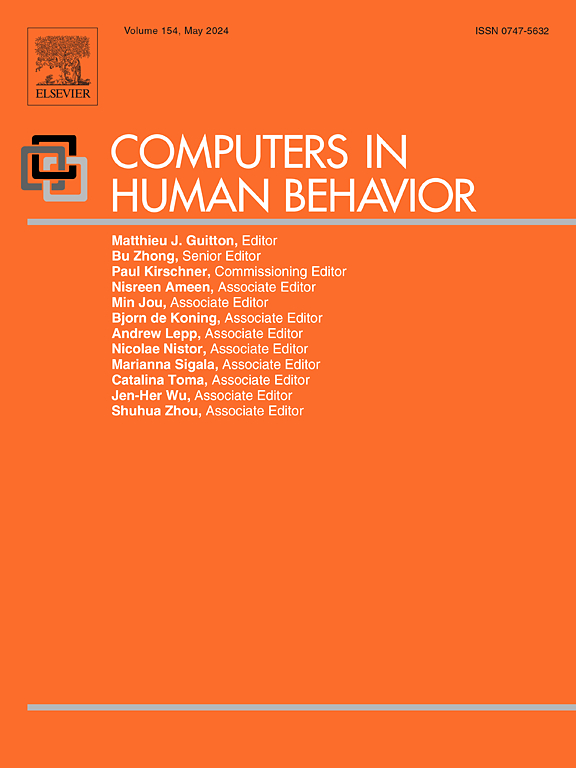使用数字角色再现感知疼痛强度和亲社会行为中的年龄和性别偏见
IF 9
1区 心理学
Q1 PSYCHOLOGY, EXPERIMENTAL
引用次数: 0
摘要
共情始于对他人情感状态的感知(例如,通过面部表情),并可能导致亲社会行为。这些阶段可以分为共情连续体。后者会受到几个因素的影响,包括年龄和性别。Gingras等人(2021)的一项研究调查了这些特征如何影响对他人痛苦的共情连续体的第一阶段(感知)和最后阶段(帮助)。他们发现,使用患者的照片,老年人比年轻人、男性比女性患者感受到更多的疼痛,并提供更多的帮助,但没有发现相互作用。即使疼痛强度在不同条件下具有全球可比性,刺激也不是在不同动作单元的水平上控制的。本研究旨在利用动态数字字符复制先前的研究结果,从而更好地控制刺激。57名参与者(年轻28人,年长29人;29名男性,28名女性)观看了8个数字角色的视频(4个小角色,4个大角色;4名男性,4名女性)表达痛苦,并对痛苦程度和他们愿意提供的帮助进行评级。研究结果重复了Gingras等人(2021)的研究结果,并通过性别互动增加了年龄:老年男性得到了更多的帮助,他们的疼痛感比老年女性高。这项研究表明,在人类与数字角色互动的共情连续体中,年龄和性别偏见存在,强调了年龄歧视和性别歧视之间的交集,并展示了数字角色在实验控制下检验心理学研究假设的潜力。本文章由计算机程序翻译,如有差异,请以英文原文为准。
Reproducing age and sex biases in perceived pain intensity and prosocial behaviors using digital characters
Empathy begins with the perception of others’ affective states (e.g., through facial expressions) and can lead to prosocial behaviors. These stages can be grouped into the empathy continuum. The latter can be influenced by several factors, including age and sex. One study by Gingras et al. (2021) investigated how these characteristics affect the first (perception) and last (help) stages of the empathy continuum for the pain of others. They found, using picture of patients, that more pain was perceived and more help was offered to older than younger and to male than female patients, but no interaction was found. Even if pain intensity was globally comparable across conditions, the stimuli were not controlled at the level of the different action units. The present study aimed to replicate previous findings using dynamic digital characters, thereby providing better control over stimuli. Fifty-seven participants (28 younger, 29 older; 29 males, 28 females) watched videos of eight digital characters (4 younger, 4 older; 4 males, 4 females) expressing pain and rated the intensity and the help they would offer. The findings replicated those of Gingras et al. (2021) with the addition of an age by sex interaction: older males received more help, and their pain was perceived as higher than older females. This work demonstrates age and sex biases in the empathy continuum in human-digital character interactions, highlights the intersection between ageism and sexism and shows the potential of digital characters to test research hypotheses in psychology with great experimental control.
求助全文
通过发布文献求助,成功后即可免费获取论文全文。
去求助
来源期刊

Computers in Human Behavior
Multiple-
CiteScore
19.10
自引率
4.00%
发文量
381
审稿时长
40 days
期刊介绍:
Computers in Human Behavior is a scholarly journal that explores the psychological aspects of computer use. It covers original theoretical works, research reports, literature reviews, and software and book reviews. The journal examines both the use of computers in psychology, psychiatry, and related fields, and the psychological impact of computer use on individuals, groups, and society. Articles discuss topics such as professional practice, training, research, human development, learning, cognition, personality, and social interactions. It focuses on human interactions with computers, considering the computer as a medium through which human behaviors are shaped and expressed. Professionals interested in the psychological aspects of computer use will find this journal valuable, even with limited knowledge of computers.
 求助内容:
求助内容: 应助结果提醒方式:
应助结果提醒方式:


